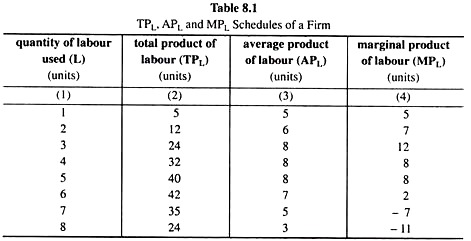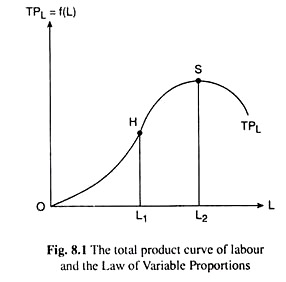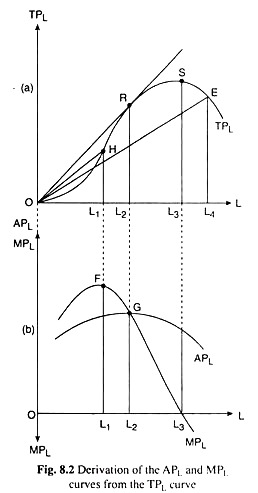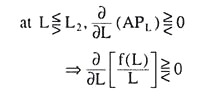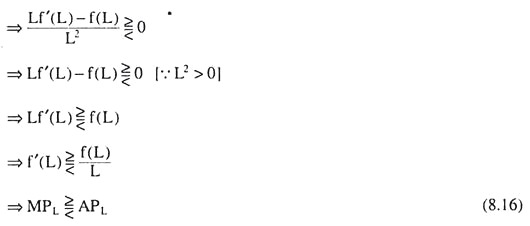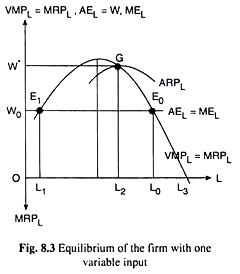In this article we will discuss about the Production in the Short Run with One Variable Input:- 1. Total, Average and Marginal Product of a Variable Input 2. Total Product of Labour (TPL) Curve and the Law of Variable Proportions 3. The Average Product of Labour (APL) and the Marginal Product of Labour (MPL) Curves—Derivation of the APL and MPL Curves from the TPL Curve and Other Details.
Contents:
- Total, Average and Marginal Product of a Variable Input
- Total Product of Labour (TPL) Curve and the Law of Variable Proportions
- The Average Product of Labour (APL) and the Marginal Product of Labour (MPL) Curves—Derivation of the APL and MPL Curves from the TPL Curve and Other Details
- Relation between the Average and Marginal Product of a Variable Input
- Derivation of the MPL – APL Relation—the Calculus Method
- Returns to a Factor
- Equilibrium of the Firm in Production with One Variable Input and Efficiency of the Second Stage of Production
1. Total, Average and Marginal Product of a Variable Input:
Total Product:
The firm uses a number of inputs to produce its output. If the firm varies the quantity of only one input, keeping the other input quantities unchanged, then the quantity of its output obtained at any quantity of the variable input is called the total product of the input.
ADVERTISEMENTS:
For example, if the said variable input is labour and if it is obtained that the firm produces 42 units of output when it uses 6 units of labour along with the fixed inputs, then we say that the total product of labour is 42 units when 6 units of labour are used.
The schedule of total product obtained at different quantities of labour used by the firm is called the total product schedule of labour—it expresses the total product of the firm (i.e., the total quantity of output) as a function of the quantity of labour used. This function is called the total product function.
Columns (1) and (2) of Table 8.1 constitute the total product schedule or total product function of labour. This function may be written as
ADVERTISEMENTS:
q = f (L) (8.8)
or, TPL = f (L) (8.9)
Here q or TPL is the total product of the firm or the total product of labour and L is the quantity of labour used.
Average Product:
ADVERTISEMENTS:
If we divide the total product of an input by the quantity used of it, we obtain the average product of the input. For example, if the total product of labour is 40 units per day when the firm uses 5 units of labour per day, then the average product of labour (APL) would be 40/5 or 8 units.
The average product schedule obtained at different quantities of labour used is called the average product schedule of labour—this schedule expresses APL as a function of labour. Columns (1) and (3) of Table 8.1 constitute the AP schedule of labour or the AP function of labour. We may express this function as
APL = q/L = f(L)/L = g(L) (8.10)
Marginal Product:
Marginal product of a variable input, say, labour (MPL), is the increment in total product of labour (TPL) obtained as a result of the use of the marginal (or an additional) unit of labour.
For example, if the TPL be 32 units and 40 units, respectively, when the firm uses 4 and 5 units of labour, then the marginal product of labour (MPL) at L = 5 units would be the increment in TPL that would be obtained as a result of the use of the 5th unit of labour, and so here we would have MPL = 40 – 32 = 8 units.
On the basis of the above definition of MPL, we may write:
(MPL)L = n units = (TPL)L = n units – (TPL)L = n- 1 units (8.11)
It is obtained from (8.11) that the firm’s MPL would be positive or negative according as the firm’s total product rises or falls when an additional unit of labour is used.
ADVERTISEMENTS:
Lastly, it follows from the above definition of MPL that MPL is the rate of change of total product of labour w.r.t. the quantity of labour used.
That is why we may write:
(8.12) gives us the marginal product of labour function and it also gives us that MPL is the slope of the TPL function or the TPL curve.
ADVERTISEMENTS:
Columns (1) and (4) constitute the MPL schedule which gives us the marginal product of labour at different quantities of labour used. This schedule expresses the MPL as a function of L.
2. Total Product of Labour (TPL) Curve and the Law of Variable Proportions:
Total product of labour (TPL) and the TPL schedule. The total product of labour or the total product of the firm at any particular quantity of labour used can be known from the TPL schedule and also from the TPL curve, the latter being the graph of the former. A hypothetical TPL curve of a firm has been given in Fig. 8.1. This curve gives us that TPL at L = L1 is L1H and TPL at L = L2 is L2S.
Now we have to remember certain points if we are to explain the shape of the TPL curve. It has been found from the experience of production of goods and services that if the firm increases the quantity used of a variable input, say, labour, other input quantities remaining unchanged, then, initially, TPL increases and at an increasing rate, i.e., initially, the slope of the TPL curve while being positive, increases.
That is why, in the initial stage, the TPL curve would be positively sloped and convex downwards. But if L increases beyond a certain quantity (beyond L = L1 in Figure 8.1), TPL increases but at a diminishing rate. That is why the TPL curve now would be positively sloped and concave downwards.
ADVERTISEMENTS:
Then at a certain L (at L=L1), the TPL becomes maximum and the TPL curve reaches its highest point. Lastly, if L increases beyond this value, (i.e., L = L2), TPL would be diminishing and the TPL curve would be sloping downwards towards right.
The Law of Variable Proportions (LVP):
The laws that the total product of the firm would follow when the firm increases the quantity of the only variable input (here labour), and when the proportion between the variable input and the fixed inputs varies. That is why these laws, taken together, are known as the law of variable proportions.
As it is obtained from above, the law of variable proportions (LVP) consists of three laws, those of increasing, diminishing and constant returns. Initially, production with one variable input (labour) follows the law of increasing returns.
According to this law, output would increase at an increasing rate as the quantity of labour increases. Graphically, this law is represented by the convex downwards segment of the TPL curve (for example, the segment OH of the TPL curve of Fig. 8.1, for 0 ≤ L ≤ L1).
ADVERTISEMENTS:
At the end of the stage of increasing returns, production follows the law of diminishing returns. According to this law, output would increase at a diminishing rate as labour is used more and more. Graphically, this law is represented by the positively sloped and concave downwards portion of the TPL curve (for example, the segment HS of the TPL curve for L1 ≤ L ≤ L2).
At the end of the stage of diminishing returns, i.e., at L = L2, the firm’s output reaches the maximum. If the firm still increases its use of labour beyond L = L2, the firm’s output diminishes and we have the negatively sloped portion of the TPL curve. This is the stage of negative returns. If we assume that the firm does not have labour free of cost, this stage is not relevant for the firm’s decision-making.
Lastly, we may add that there may be a (small) stage of constant returns between the stages of increasing and diminishing returns. In this stage output increases at a constant rate as L increases, and the TPL curve becomes an upward sloping straight line. Generally, this stage is found to be very small.
If this stage is not obtained, i.e., if diminishing returns set in as soon as the stage of increasing returns ends, we have a point of inflexion like the point H. At this point the TPL curve changes its shape from being convex downwards to being concave downwards.
3. The Average Product of Labour (APL) and the Marginal Product of Labour (MPL) Curves—Derivation of the APL and MPL Curves from the TPL Curve:
We have assumed that the firm uses only one variable input, labour, to produce its output. The APL and the MPL curves are the graphs of the APL and the MPL schedules (like those given in Table 8.1). The average and marginal products of labour at any L can be known from the APL and MPL schedules and also from the APL and the MPL curves.
The shapes of the APL and MPL curves would be like the curves given in Fig. 8.2—their shapes would be like an inverted-U. The characteristic features of their shapes are obtained from the shape of the TPL curve. Since, the shape of the TPL curve reflects the law of variable proportions, the shapes of the APL and MPL curves are also derived from this law.
ADVERTISEMENTS:
We shall now explain how the APL curve is derived from the TPL curve with the help of Fig. 8.2. In part (a) of this figure, at L = L1 = OL1, we have TPL = L1H and APL = TPL/L = L1H/OL1 = the slope of the line OH which is called the guide line to the TPL curve at point H.
Therefore, generally speaking, APL at any L would be equal to slope of the guide line to the TPL curve at the corresponding point on it. For example, APL at L = L2 and L4 would be, respectively, the slopes of the guide line to the TPL curve at the points R and E.
Now, it follows from the shape of the TPL curve that as L rises, the slope of the guide line to this curve, i.e., APL, increases till it becomes maximum when the guide line touches the TPL curve and thereafter as L rises, the slope of the guide line, i.e., APL, diminishes.
In Fig. 8.2(a), the guide line touches the TPL curve at the point R or at L = L2. We obtain, therefore, that APL rises as L rises till it becomes the highest at L = L2 and then as L rises APL: diminishes. So in Fig. 8.2(b), we obtain the APL curve to be an inverted-U—it is a second degree curve and it reaches its maximum at L = L2 or at the point G.
We shall now see how we may derive the MPL curve from the TPL curve. By definition, MPL is the derivative of TPL w.r.t. L, i.e., MPL is the slope of the TPL curve.
ADVERTISEMENTS:
Therefore, initially, when the TPL curve is convex downwards in the stage of increasing returns, we obtain that, as L rises, the slope of the TPL curve rises, i.e., MPL rises, and at L = L1 or at the point of inflexion H on the TPL curve, i.e., at the last point on its convex downwards portion, the slope of the TPL curve, i.e., MPL reaches its maximum.
Thereafter, as L rises and as we move along the concave downwards portion of the TPL curve in Fig. 8.2(a), the slope of the TPL curve or MPL diminishes till it becomes zero at L = L3 when the TPL curve reaches its maximum, and thereafter as L rises MPL becomes negative.
Therefore, in Fig. 8.2, we obtain the MPL curve also, like the APL curve, to be an inverted-U second degree curve. Here the MPL curve reaches its maximum at L = L1 or at the point F, and the curve intersects the L-axis at L = L3 when MPL falls to zero, and thereafter the MPL curve falls below the L-axis and MPL becomes negative.
4. Relation between the Average and Marginal Product of a Variable Input:
We shall derive here the relation between the average and marginal product of a variable input, say, labour, with help of an easy example. Let us suppose that the firm uses 9 units of labour (L = 9) and produces 54 units of output [q = f (L) = 54], Therefore, here we have APL = 9 = 54/9 = 6 units.
If the firm now uses one more unit of labour, keeping the other input quantities unchanged, i.e., if the firm now uses 10 units of labour, then the increment in total product would be the marginal product at L= 10, or MPL = 10.
Now, if MPL= 10 > APL=9 , then APL would increase, i.e., we would have APL=10 > APL = 9. For example, if MPL=10 = 7 (> 6), then we have APL=10 = 54 + 7/10 = 6.1 (> 6). That is, if MPL > APL as L rises, then APL would increase.
ADVERTISEMENTS:
Therefore, conversely, if APL rises as L rises, then we have MPL > APL. This is the first point of the relation between MPL and APL.
Again, if MPL= 10 = APL = 9 (= 6), then we would have APL= 10 = APL = 9, i.e., APL would remain unchanged. For, now, we have APL=10 = 54 +6/10 = 6 Therefore, we have obtained here that if as L rises, MPL = APL, then APL would remain unchanged. Conversely, we get, if APL remains unchanged as L rises, then MPL = APL. This is the second point of the relation between MPL and APL.
Lastly, if MPL= 10 < APL=9 , if MPL= 10 = 5, say, then we would have APL=10 < APL=9. For now we would have APL=10 =54 + 5/10 = 5.9 (< 6). Therefore, here we have obtained that if, as L rises, MPL < APL, then APL would diminish. Conversely, we have: if APL diminishes as L rises, then we should have MPL < APL. This is the third point of the MPL -APL relation.
The MPL-APL relation that we have been able to derive above has been represented in Fig. 8.2(b). Here the shape of the continuous APL curve has been like an inverted-U and G is the maximum point of this curve. Therefore, at the point G (i.e., at L = L2), APL would remain the same if L changes by an infinitesimally small quantity (since here the analysis is a continuous analysis).
This gives us MPL = APL at the maximum point G on the APL curve, where L = L2. This is the second point of the relation. Therefore, the point G or the maximum point on APL is the point of intersection between the MPL and the APL curves.
Also, since the APL curve is an inverted-U and G (L = L2) is its maximum point, we obtain that, to the left of G (for L < L2), as L rises, APL also rises. Therefore, the first point of MPL-APL relation gives us MPL > APL or the MPL curve lies above the APL curve when L < L2.
Similarly, to the right of the point G (for L > L2), as L rises APL declines. Therefore, the third point of MPL– APL relation gives us MPL< APL or the MPL curve lies below the APL curve when L > L2. Therefore, we have corresponding to the three points of MPL– APL relation, we have three points of relation between the MPL and APL curves.
These points are:
(i) The two curves intersect at the maximum point on the APL curve,
(ii) To the left of this maximum point, when the APL curve is upward sloping, the MPL curve lies above the APL curve, and
(iii) To the right of this maximum point, when the APL curve is downward sloping, the MPL curve lies below the APL curve.
5. Derivation of the MPL – APL Relation—the Calculus Method:
We may derive the relation between the MPL and the APL with the help of calculus also. Let us suppose that the production function of the firm which uses only one variable input, labour, is
q = f(L) (8.13)
where L is the quantity of labour used per period and q is the quantity of output produced per period. By definition, the average and marginal product of labour (APL and MPL) are
As we know, both the APL and the MPL curves would be inverted-Us because of the law of variable proportions (LVP). We have shown these curves in Figure 8.2(b).
Since the APL curve is an inverted-U, it would reach its maximum at some L, and to the left and right of this maximum, the curve would be upward sloping (i.e., positively sloped) and downward sloping (i.e., negatively sloped), respectively. In Fig. 8.2(b), the APL curve has reached its maximum at the point G (when L = L2). Therefore, we obtain
From (8.16), we obtain the following points of relation between the MPL and APL and between the MPL and APL curves as shown in Fig. 8.2:
(i) When L < L2, we would have MPL > APL. That is, to the left of the maximum point G on the APL curve, we obtain MPL > APL, and the MPL curve would be above the APL curve.
(ii) When L = L2, we would have MPL = APL. That is, at the maximum point G on the APL curve, we obtain MPL = APL, and the MPL and APL curves would intersect each other at this point.
(iii) When L > L2, we would have MPL < APL. That is, to the right of the maximum point G on the APL curve, we obtain MPL < APL, and the MPL curve would lie below the APL curve.
(iv) It follows from (i), (ii) and (iii) above that the MPL curve is above the APL curve to the left of the point G and it is below the APL curve to the right of this point.
This gives us that the MPL curve is downward sloping at the point G (L = L2) which is the maximum point of the APL curve, and the MPL curve, an inverted-U, must have reached its maximum at some point to the north-west or upwards towards left of point G where L < L2.
This point, as we see in Fig. 8.2(b), is the point F (L = L1 < L2). If we compare the points F and G, we find that L at point F = L1 < L at point G = L2 and MPL at point F = maximum MPL = L1F > APL at point G = maximum APL = L2G. From this we obtain that the MPL curve reaches its maximum earlier (at a lower L) than the APL curve and the maximum MPL is greater than the maximum APL.
6. Returns to a Factor:
The Three Stages of Production and the Law of Variable Proportions (LVP):
In the theory of production with only one variable input, the economists have distinguished between three stages of production, depending on the nature of the response of output to changes in the quantity of the variable factor (labour). The first stage of production is the stage of MPL being greater than APL.
Since APL rises so long as MPL remains greater than APL, this stage is also the stage of rising APL and the stage ends at the maximum point [G in Fig. 8.2(b)] on the APL curve. In Fig. 8.2, the range of this stage is 0 ≤ L ≤ L2, i.e., so long as labour employment is between 0 and L2, the production is in the first stage. This stage is also called the stage of increasing returns.
The second stage of production is the stage of MPL being less than APL, while remaining non-negative. The second stage begins where the first stage ends, i.e., the stage lies to the right of the maximum point G (Fig. 8.2) on the APL curve and runs up-to the point of intersection L3 between the MPL curve and the L-axis.
The range of the stage is L2 ≤ L ≤ L3. Since this stage lies to the right of the maximum point G on the APL curve, both APL and MPL fall in this stage as L rises. This stage is also known as the stage of diminishing returns.
Finally, the third stage is the stage of negative MPL. This stage begins where the second stage ends, i.e., the stage lies to the right of the point L3 in Fig. 8.2. The range of L for this stage is L > L3. This stage may be called the stage of negative returns.
Conditions for the Applicability of the Law of Variable Proportions:
There are two main conditions for the applicability of the LVP:
(i) The production function or the technology of the firm should remain unchanged. For, if there occurs continuous improvement in technology, returns would be obtained at an increasing rate even if the use of the variable factor (labour) goes on increasing indefinitely.
(ii) The question of applicability of LVP arises only when the inputs can be used in variable proportions. There may be some areas of production where the inputs are to be used in a fixed ratio. In these areas if the use of the variable factor is increased and that of all other factors remains constant, the resulting change in output would be zero.
Therefore, here, the marginal product of the variable factor would be zero—it would not be diminishing, nor increasing.
Explanation of the Law of Variable Proportions:
The LVP states that if the use of a factor of production (labour) increases, that of all other factors of production remaining constant, then returns would be obtained first at an increasing rate, then at a diminishing rate and then at a negative rate. Explanation of LVP requires the explanation of all the three phenomena of increasing, decreasing and negative returns.
Increasing Returns:
The first stage of production is the stage of increasing APL and this stage is known as the stage of increasing returns. In this stage, the range of labour use is 0 ≤ L ≤ L2 in Fig. 8.2. The portion of the TPL curve from the point of origin to point R represents this stage of production. The total rising portion of the APL curve falls in this stage.
Now, why do we get increasing APL in this stage? This is because, in the initial stages of production, the firm uses much less of labour in relation to its fixed inputs. Therefore, as the use of labour increases in this stage the fixed inputs are used more and more intensively and effectively.
That is why in this stage, the increase in the use of labour results in an increase in production by a larger proportion which gives us an increase in APL.
We have to note here that in the initial stages the firm uses a relatively small quantity of labour, but the fixed input quantities with the firm are much larger than what are needed initially. This is because of two reasons.
First, in general, the quantity of output produced initially happens to be relatively small.
Second, the fixed inputs like the factory building and machines and appliances are indivisible for technological reasons and their size cannot be reduced below a certain minimum. That is, no matter however small the quantity of output is initially, and however small the quantity of labour used, fixed inputs used cannot be reduced accordingly.
Apart from the indivisibility of the fixed inputs, another cause of increasing returns is the specialisation and division of labour that can be put into practice as the use of labour increases in the initial stages to produce increasing quantities of output.
Decreasing Returns:
The stage of production—the second stage as we know—when both APL and MPL are decreasing as the use of labour increases is known as the stage of diminishing returns. In this stage the quantity of labour used (L) lies in the range L2 ≤ L ≤ L3 in Fig. 8.2. The corresponding segment of the TPL curve runs from the point R to the maximum point of the curve, viz., point S.
We have to explain why the second stage is the stage of diminishing returns. In the first stage, as the use of labour increases, the fixed inputs are used more and more intensively and effectively.
But if the quantity of labour used becomes more than a certain quantity, which is L2 in Fig. 8.2, there develops a shortage of fixed inputs in relation to labour. That is why if the use of labour is increased now, output would increase in a smaller proportion. Consequently, both APL and MPL would fall as L increases.
It is clear from the above analysis that increasing returns in the first stage result from the indivisibilities of fixed inputs. Similarly, decreasing returns in the second stage are also caused by the same indivisibilities.
In the first stage, fixed inputs are plenty in relation to labour owing to indivisibilities, leading to increasing APL, and in the second stage, when a shortage in fixed inputs develops, their quantities cannot be increased (in the short run) also owing to indivisibilities of these inputs, resulting in decreasing APL and MPL.
Prof. Joan Robinson (1903—83) has gone deeper into the causes of diminishing returns. She tells us that diminishing returns are obtained because the factors of production are not perfect substitutes of each other.
If the variable factor, labour, had been a perfect substitute for the fixed inputs, then it might have been possible to make up for the deficit of the fixed inputs by using more of labour and in that case we might have obtained constant returns in place of diminishing returns. Therefore, according to Prof. Robinson, diminishing returns are caused by limited substitutability between the factors of production.
Negative Returns:
In the third stage of production the MPL is negative. This stage is known as the stage of negative returns. In this stage the TPL diminishes as L increases. Here the range of labour use is L > L3 in Fig. 8.2.
The segment of the TPL curve corresponding to this range is one that lies to the right of its maximum point. We may explain the negative returns to labour in this way. In the second stage, there is shortage of fixed inputs.
This causes both the MPL and APL to be diminishing. But if the use of labour increases beyond a certain point, shortage of fixed inputs in relation to labour becomes so large or the employment of labour in relation to the fixed inputs becomes so large that now the TPL starts falling or MPL becomes negative. Exactly this happens in the third stage where L becomes greater than L3.
7. Micro-Economics, Production Theory, Short Run Production, One Variable InputEquilibrium of the Firm in Production with One Variable Input and Efficiency of the Second Stage of Production:
Here we shall assume that the firm uses only one variable input (labour) along with some fixed inputs to produce its output. We shall now discuss how the firm determines how much of labour to buy and what quantity of output to produce.
The assumptions:
We shall assume:
(i) The firm is using only one variable input, labour, along with other fixed inputs. The short-run production function of the firm is
Q = f (L) (8.17)
(ii) The price P of the product is given and constant, and the firm can sell any quantity of output at this price. That is, there is perfect competition in the product market.
(iii) The price of labour, i.e., the rate of wage (W), is also given and constant, and the firm can buy any quantity of labour it requires, at this wage in the perfectly competitive labour market.
(iv) The firm’s goal is to buy labour and produce the product in appropriate quantities so that its profit is maximised.
Definitions:
Before we proceed to establish the decision-making rule of the firm, let us define certain concepts and ideas that we have to use here.
First, we should note that profit (π) of the firm per period is the difference between its revenue and cost per period. Revenue is obtained from the sale of the firm’s output which again is produced by the variable input, labour (along with some fixed inputs).
So revenue here is a function of labour quantity used (L) and is known as total revenue product of labour (TRPL). Fixed input quantities being fixed, would not enter into this function. Corresponding to TRPL, we would have
And MRPL (marginal revenue product of L) = MPL x P (... P is constant) = VMPL
Here VMPL is the value of MPL. Both ARPL and MRPL are function of L.
On the cost side, total cost (TC) is made up of total expense for labour (TEL) and total fixed cost (TFC) for the fixed inputs. TEL is a function of labour quantity purchased (L).
Corresponding to TEL, we would have
Both AEL and MEL are functions of L.
The Profit Function of the Firm and Profit-maximisation:
Here, the profit function of the firm would be
So π would have to be maximized w.r.t. L. Since TFC is constant w.r.t. L, or, Q (the firm would have to bear TFC even if L, or, Q is zero), we can maximize π
If we maximize TRPL (L) = πL, say.
The first-order condition for maximum πL (and of maximum π) is
Conditions (8.18) gives us that, at any given W, πL would be maximised at that L at which the firm would remain on the MRPL curve. For example, at W = W0, the firm’s πL would be maximised at L = L0. In other words, profit- maximisation requires that the firm’s demand curve for labour will be its MRPL curve. However, condition (8.19) requires that at this L, the MRPL curve should be sloping downward towards right.
Therefore, taken together, these two conditions require that at any W, πL would be maximised at some point on the downward-sloping segment of its MRPL curve. For example, in Fig. 8.3, at W = W0, the firm would be in profit-maximising equilibrium at the point E0 employing L0 units of labour. Output at this L would be Q0 = f (L0) units [by virtue of (8.17)].
πL Should be Greater than Zero:
But one important point we should remember here. If at the πL-maximising point, maximum n:L is negative i.e., if TEL > TRPL, the magnitude of TEL-TRPL being minimum, then the firm would not be able to recover even its variable cost (or, labour expenses) with its revenue or TRPL. Under the circumstances, it would shut down its operations.
This is because, in the short run, the firm cannot avoid bearing the fixed cost, but it can avoid the cost for the variable input, labour, by reducing its output to zero. We may also note that, in the event of facing losses, the task of profit maximisation becomes one of loss minimisation. By shutting down its operations, the firm would be minimising its loss which would now be equal to the amount of its fixed cost.
The firm’s optimum point:
Therefore, the optimum point of the firm becomes the point of πL-maximisation subject to the condition:
This last condition gives us that, at any W ≤ ARPL, i.e., at any W ≤ W* in Fig. 8.3 (where W* = maximum ARPL), or, at the corresponding L ≥ L2, the firm would be in equilibrium at the appropriate point on the downward-sloping segment of its MRPL curve, and at any W > ARPL, i.e., at L < L2, it would shut down.
The MRPL cannot be Negative:
Also, in the real world, W ≠0 and at W ≥ 0 and MRPL < 0, the firm would run into a loss on the marginal unit(s). So the firm cannot be in equilibrium at any point where MRPL is negative, i.e., it cannot be in equilibrium at any L > L3.
The Final Optimisation:
In production with one variable, the firm may be in profit-maximising (or loss-minimising) equilibrium at some point on the stretch of its MRPL curve that starts on and from the maximum point (G) on the ARPL curve and ends at the point of intersection (L3) between the MRPL curve and the L-axis. The corresponding range of labour employment is L2 ≤ L ≤ L3 in Fig. 8.3.
Efficiency of the Second Stage of Production:
In Fig. 8.3, ARPL is maximum at L = L2. This implies APL is maximum at L = L2, since ARPL = APL x P where P is constant. Also, MRPL is equal to zero at L = L3 implies MPL is zero at L = L3, since MRPL = VMPL = MPL x P where P is a non-zero constant.
In other words, the stretch of the MRPL curve from the maximum point on the ARPL curve to the point where the MRPL curve meets the L-axis corresponds to the stretch of the MPL curve, in Fig. 8.2(b), from the maximum point of the APL curve at L = L2 to the point where the curve meets the L-axis at L = L3.
This latter stretch of the MPL curve is, by definition, the second stage of production. Therefore, that production can occur only at L2 ≤ L ≤ L3, i.e., only in the second stage. That is why the second stage of production is the economically efficient stage of production.
It is important to note here, that the rising portion of the SMC curve of a firm corresponds to the falling portion of the MP curve of the variable input(s), and so, it follows from above that a particular segment of the rising portion of the SMC curve would correspond to the economically efficient second stage of production (which is again a particular segment of the falling portion of the MP curve).
In other words, the point at which a profit-maximising firm would operate in equilibrium must lie on the upward- sloping portion of its SMC curve.
